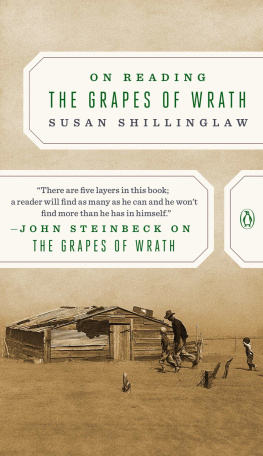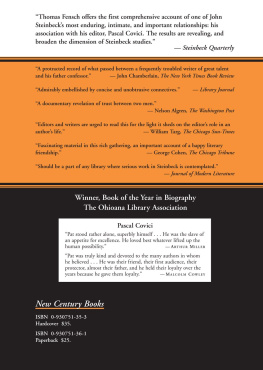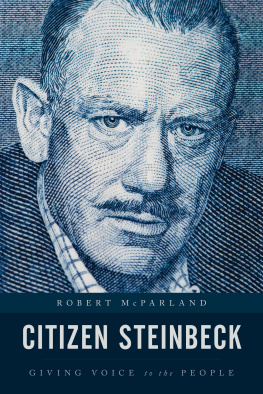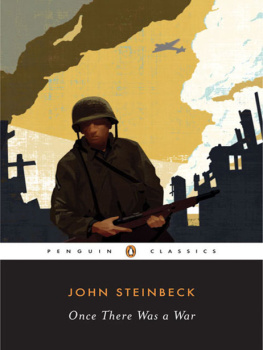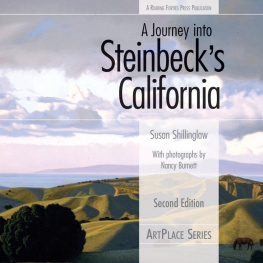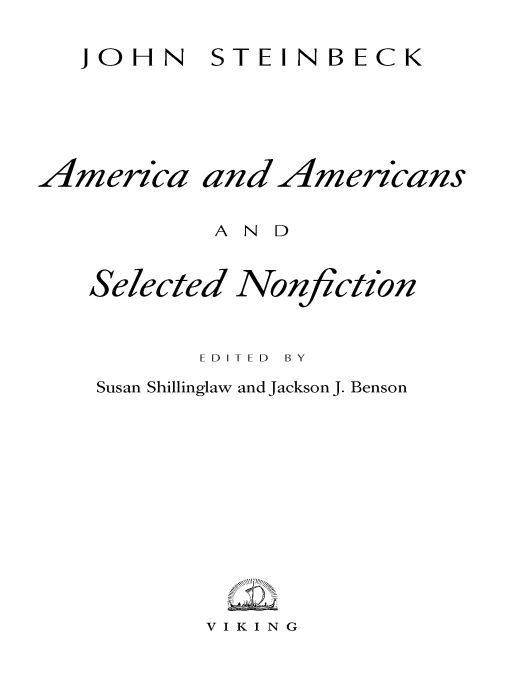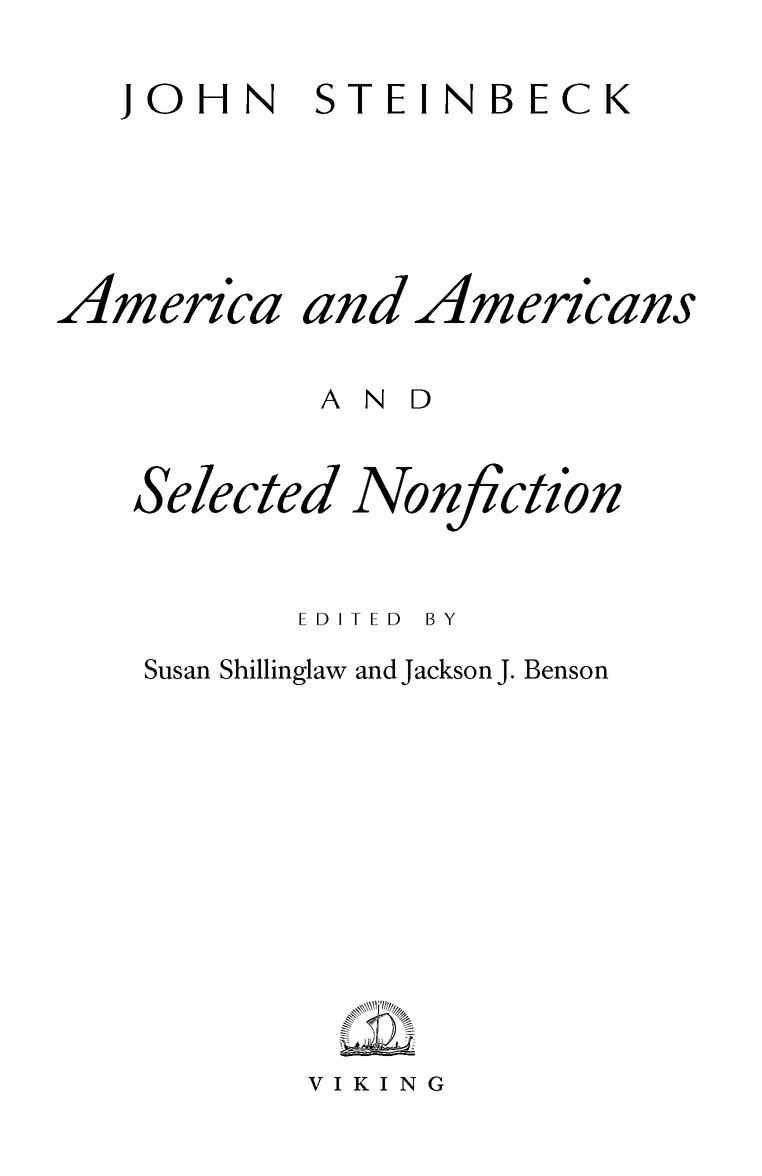Table of Contents
INTRODUCTION
MOST AMERICANS know John Steinbecks name, and many know his novels: The Grapes of Wrath, Of Mice and Men, Cannery Row, and East of Eden. His books, both fiction and nonfiction, still sell millions of copies every year, and one or another is part of the curriculum in schools throughout the United States. Few writers become beloved, their writing read with affectionate response long after their death. And few writers as popular as Steinbeck have written books that have for so long withstood critical and cultural crosscurrents. Like some other authors, such as Mark Twain, Robert Frost, and Willa Cather, John Steinbeck became beloved because he was so essentially American, a writer for and about the people.
But while his novels are familiar to many, his nonfiction is hardly known. From 1936 to 1966, Steinbeck wrote scores of short nonfiction pieces published in a variety of magazines and newspapers here and abroad. Most were read widely at the time and then gradually forgotten. By and large, however, these pieces are curiously modern and relevant. Steinbeck was a writer fully engaged in social currents, politics, and history. He takes on issues vital to the twentieth centurythe environment, poverty and homelessness, Americas moral decline, major wars, racism, ethnicity. Other essays recount his life, his travels, his ideas, his projects. The range is impressive, the style unadorned and engaging, and the voice remarkably variedreportorial, witty, impressionistic, impassioned.
This volume, published in celebration of Steinbecks centennial, brings together for the first time representative articles, essays, and columns from his role as journalist and commentator. Also reprinted here for the first time since its original publication in 1966 is his last book, a series of commentaries on American life, America and Americans. Included also is the final, heretofore unpublished, chapter of Travels with Charley (1962). Some of these articles and essays are provocative, some moving, some thoughtful, and others amusing.
What can I say about journalism? he wrote in 1956. It has the greatest virtue and the greatest evil. It is the first thing the dictator controls. It is the mother of literature and the perpetrator of crap. In many cases it is the only history we have and yet it is the tool of the worst men. But over a long period of time and perhaps because it is the product of so many men, it is perhaps the purest thing we have (SLL 526). In many ways, this selection of Steinbecks nonfiction is the purest record of a writer immersed in his times. What reviewer Lewis Gannett said of Sea of Cortez may be extended to Steinbecks corpus of literary journalismthere is here more of the whole man, John Steinbeck, than in any of his novels.
Like Mark Twain before him, Steinbeck was a great democrat, skeptical of power and privilege, seeking to encourage the best that is in us and doing so sometimes in sorrow, sometimes in frustration or even anger, but sometimes, too, with tongue in cheek and a sly smile. In his roles as novelist or journalist, he always did his besthe cared deeply about his work, but like Twain, he seldom took himself too seriously. When he volunteered to cover the national political conventions in 1956, he wrote to the editors of the syndicated newspapers who would publish his columns: Walter Lippmann, the Alsops and David Lawrence have nothing to fear from me. I have no sourcesdependable or otherwise. If I should make a prediction, it will probably be assembled out of information from the wife of the alternate delegate from San Jose, California, plus whispers from the bell-hop who has just delivered a bucket of ice to usually dependable sources (SLL 526).
Steinbeck had a knack for choosing topics, as well as taking an approach, that would be of interest to ordinary people, usually putting himself in their place. But above all he had the ability through it all to entertain and inform. Indeed, these articles form a series of snapshots of a man who, through his compassion, concern, and sense of fun, has endeared himself to the American public, both in his life and since his death. Its in the spirit of that great range that the book is organizedby topics that suggest the power of his thinking, the scope of his enthusiasms, and the varied approaches he took to the craft of literary nonfiction.
John Steinbeck was lucky enough to live at a time when the concept of journalism as a profession was a fairly flexible notion. Newspapers sent novelists to cover stories, and Steinbeck, his reputation firmly grounded in the American psyche after The Grapes of Wrath, was fortunate to have his pick of material. Publications were usually happy to have his work, not only because of his name, but because he developed a reputation for applying his skills to even the most casual of pieces. From the time he published his first article in 1936 to his last in 1966, he took the writing of these little articles seriously, fretting over each one of them. You know as well as I do that I have never turned out a really easy piece of copy in my life, he wrote his agent Elizabeth Otis during a frustrating moment on assignment in 1952. These articles are going to be just exactly as hard as anything I have ever done (SLL 451).
Journalism was seldom effortless in large part because Steinbeck was always the novelist, shaping, arranging, creating characters and scenes and conversations, occasionally drifting into the fanciful or mining the fantastic. His work in both nonfiction and literary journalism always teases the border between fiction and nonfiction, between the fanciful and factual. If his migrant material of the 1930s swings toward the documentary and reportorial, his work of the 1950s and 1960s freely mixes moods, narrative approaches, and fictional techniques. Some of this may have been temperamenthe was, in fact, fired from a reporting job in 1925 on the New York American because his news stories drifted from the factsbut some he may have picked up from muckraking journalist Lincoln Steffens, who lived near Steinbeck in the 1930s. Steffens was undoubtedly Steinbecks political mentor; it was he who, in 1935, urged the writer to interview strike organizers hiding out on the Monterey Peninsula. Abandoning his initial notion to write a biography of an organizer, Steinbeck published In Dubious Battle (1936), the first of three labor novels. But Steffens, whose New York Commercial Advertiser had run a new kind of journalism that was, as his biographer observes, personal, literary, immediate, may also have schooled Steinbeck in his concept of descriptive narrative (Kaplan 82). A good news story should contain only life. Steffens taught not only New York reporters at the turn of the century but also scores of Stanford journalism students making pilgrimages to his Carmel home in the 1930sand John Steinbeck by 1935. When Steinbeck wrote his first feature series in 1936, The Harvest Gypsies, he knew how to see things as they are, in line with Steffenss advice to reporters.
From 1936 on, Steinbeck published his articles in more than three dozen different newspapers and magazines. Many pieces were reprinted, and many were syndicated and ran in a number of newspapers throughout the country. Four seriesor parts thereofwere collected and published separately: Their Blood Is Strong in 1938 (originally The Harvest Gypsies, which ran in the San Francisco News in 1936), Once There Was a War in 1958 (originally war dispatches that ran in the New York Herald Tribune in 1943), A Russian Journal in 1948 (parts of which ran in the Herald Tribune in January 1948), and Un Amricain New-York et Paris in 1956 (seventeen of the pieces written for Le Figaro Littraire in 1954). America and Americans was written as a book, Steinbecks last, and then published as a series in Long Islands Newsday. Other newspaper series have never been collected. His Le Figaro articles were collected only in a French edition, although a few of the pieces were published separately in American and English magazines. Two lively series for the Louisville Courier-Journal are scarcely known: one was Steinbecks coverage of the 1956 political conventions, and the other a series on his European travels a year later. And the 1966 and 1967 series called Letters to Alicia, his last and most controversial newspaper work, written for Newsday, is difficult to locate. Selections from all these series, with the exception of A Russian Journal, are included here.


